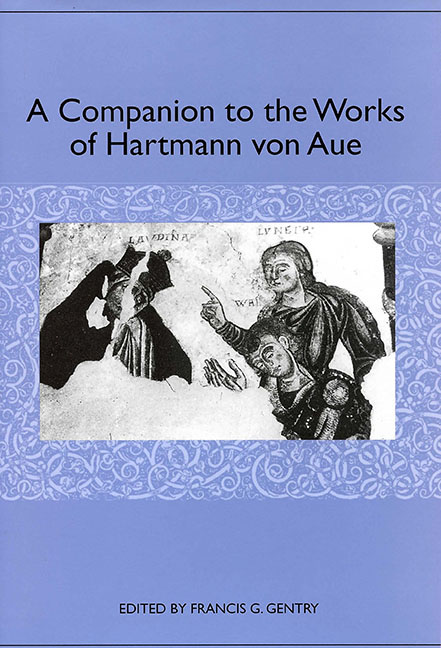Book contents
- Frontmatter
- Contents
- Acknowledgments
- Introduction
- Hartmann's Theological Milieu
- Hartmann von Aue as Lyricist
- Hartmann von Aue and Chrétien de Troyes: Respective Approaches to the Matter of Britain
- Gender and Love in the Epic Romances of Hartmann von Aue
- The Two-Fold Path: Erec and Enite on the Road to Wisdom
- The Body in Pain in the Works of Hartmann von Aue
- Illness and Cure in Hartmann von Aue's Arme Heinrich and Iwein
- Hartmann's Legends and the Bible
- Hartmann's Works in the Visual Arts
- The Medieval Literary Reception of Hartmann's Works
- A Tale of Sacrifice and Love: Literary Way Stations of the Arme Heinrich from the Brothers Grimm to Tankred Dorst
- Editions and Translations of Hartmann's Works
- Works Cited
- Notes on the Contributors
- Index
The Medieval Literary Reception of Hartmann's Works
Published online by Cambridge University Press: 27 April 2017
- Frontmatter
- Contents
- Acknowledgments
- Introduction
- Hartmann's Theological Milieu
- Hartmann von Aue as Lyricist
- Hartmann von Aue and Chrétien de Troyes: Respective Approaches to the Matter of Britain
- Gender and Love in the Epic Romances of Hartmann von Aue
- The Two-Fold Path: Erec and Enite on the Road to Wisdom
- The Body in Pain in the Works of Hartmann von Aue
- Illness and Cure in Hartmann von Aue's Arme Heinrich and Iwein
- Hartmann's Legends and the Bible
- Hartmann's Works in the Visual Arts
- The Medieval Literary Reception of Hartmann's Works
- A Tale of Sacrifice and Love: Literary Way Stations of the Arme Heinrich from the Brothers Grimm to Tankred Dorst
- Editions and Translations of Hartmann's Works
- Works Cited
- Notes on the Contributors
- Index
Summary
This contribution focuses mainly on the reception of Hartmann von Aue in the works of other medieval authors. What role did Hartmann play as an authorial figure in the medieval German literary tradition, which of his works were received most widely, and what patterns of genre, chronology, audience interest, and literary function can be discerned in this process? Manuscripts are the main tangible expressions of literary life in the Middle Ages. The known manuscripts, and the circumstances of their transmission, provide valuable evidence about a work's cultural status and popularity, and so the contribution will begin by looking briefly at aspects of the manuscript transmission of Hartmann's works that can throw light on the way his works were received.
The Manuscripts
First, with regard to the profile of Hartmann as an author working in several genres, his lyrics were transmitted under his name in the “Kleine Heidelberger Liederhandschrift” (A, 10 strophes), the “Weingartner Liederhandschrift” (B, 28 strophes), and most fully in the “Große Heidelberger (Manessische) Liederhandschrift” (C, 60 strophes), and otherwise his works were transmitted separately from each other. It is not until the “Ambraser Heldenbuch” of the early sixteenth century that a number of his works (Iwein, Erec, Klage) appear together in one codex. Thus, for over 300 years the manuscript transmission of this major author showed no interest in the oeuvre as a whole, but only in the separate works (Cormeau and Störmer, 21). Moreover, the “Ambraser Heldenbuch,” which brings the first indication in the manuscript transmission of an interest in Hartmann's works that goes beyond one genre, is already a retrospective prestige codex that comes at the end of, or even after, the living literary reception of Hartmann's works.
In terms of regional spread, the manuscripts containing Hartmann's lyrics are concentrated in the southwest. The manuscripts of his narrative works too are weighted towards the south, but they also show a wider regional spread than the lyric manuscripts, with some reception of Erec and Iwein well to the north, in the Low German area. It seems that Hartmann's Arthurian romances were quickly transmitted along an axis linking the southeast with the northern regions, and since this axis was connected with the power zone of the Welfs it may throw light on the unanswered question of the literary sponsorship of Hartmann's works (Klein, 123).
- Type
- Chapter
- Information
- A Companion to the Works of Hartmann von Aue , pp. 183 - 222Publisher: Boydell & BrewerPrint publication year: 2004

